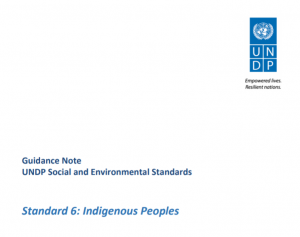From the report:
United Nation Development Programme’s (UNDP) work with indigenous peoples is grounded on its overall vision to help countries achieve the simultaneous eradication of poverty and significant reduction of inequalities and exclusion. Indigenous peoples number more than 370 million living in some 90 countries. It is estimated that they constitute 15 percent of the world’s poor, and one third of the 900 million people living in extreme poverty in rural areas.
This Guidance Note provides operational guidelines for addressing the requirements of Standard 6 Indigenous Peoples during the development and implementation of UNDP Projects.
This Guidance Note begins with an introduction to the objectives, key concepts and an overview of the requirements of Standard 6 (Section 2). Section 3 addresses requirements related to meaningful participation and free, prior and informed consent (FPIC) on indigenous peoples in UNDP Projects. Section 4 discusses how to determine if the Standard is relevant by applying the Social and Environmental Screening Procedure. It also discusses the assignment of a risk category to the project. Section 5 addresses the integration of the requirements of Standard 6 into the social and environmental assessment process. Section 6 addresses the development of measures to avoid, mitigate, and manage risks and impacts as well as monitoring implementation of management plans. All Moderate and High Risk projects require a management plan for PAC consideration (the form of which will vary depending on nature/scale of risks and timing of assessment).

